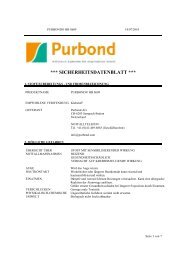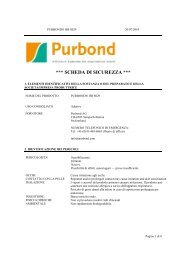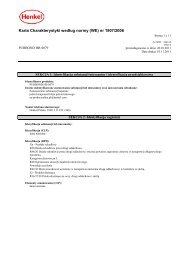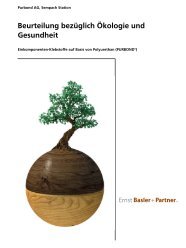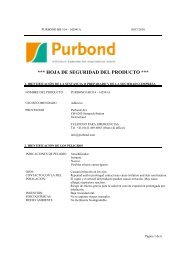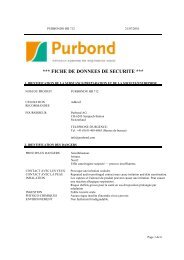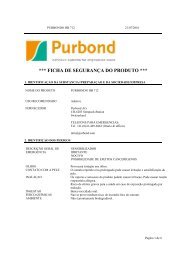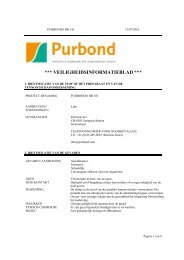MATERIAL SAFETY DATA SHEET - Purbond AG
MATERIAL SAFETY DATA SHEET - Purbond AG
MATERIAL SAFETY DATA SHEET - Purbond AG
You also want an ePaper? Increase the reach of your titles
YUMPU automatically turns print PDFs into web optimized ePapers that Google loves.
PURWELD® 1402<br />
* * * <strong>MATERIAL</strong> <strong>SAFETY</strong> <strong>DATA</strong> <strong>SHEET</strong> * * *<br />
1. CHEMICAL PRODUCT AND COMPANY IDENTIFICATION<br />
PRODUCT NAME: PURWELD® 1402<br />
- MANUFACTURER -<br />
<strong>Purbond</strong> <strong>AG</strong><br />
CH-6203 Sempach-Station<br />
Switzerland<br />
EMERGENCY PHONE:<br />
Tel. +41-(0)41-469-6863<br />
E-mail: info@purbond.com<br />
2. HAZARDS IDENTIFICATION<br />
EYE CONTACT Will cause eye irritation.<br />
SKIN CONTACT Repeated and/or prolonged contact may cause irritation and skin<br />
sensitization.<br />
INHALATION Vapors and/or aerosols may cause irritation. May cause allergic respiratory<br />
reaction.<br />
INGESTION Ingestion may cause irritation of the gastrointestinal tract.<br />
3. COMPOSITION/INFORMATION ON INGREDIENTS}<br />
CHEMICAL FAMILY Polymeric Isocyanate<br />
COMPONENT CAS NUMBER CONCENTRATION<br />
(% by weight)<br />
Polymeric Diphenylmethane diisocyanate 9016-87-9 30 - 60<br />
P<strong>AG</strong>E 1 OF 4
PURWELD® 1402<br />
4. FIRST-AID MEASURES<br />
EYE CONTACT Irrigate with eyewash solution or clean water until pain is relieved.<br />
SKIN CONTACT Wash skin with soap and water.<br />
INHALATION Remove to fresh air. If breathing is difficult, give oxygen. If breathing has<br />
stopped, give artificial respiration. Get medical attention.<br />
INGESTION Treat symptomatically and supportively. Get medical attention.<br />
5. FIREFIGHTING MEASURES<br />
AUTOIGNITION Not available<br />
FLASH POINT > 200 °C (Pensky-Martens Closed Tester)<br />
EXTINGUISHING MEDIA CO2; Dry Chemical; Foam<br />
SPECIAL FIREFIGHTING PROCEDURES Fire fighters should be equipped with self-contained<br />
breathing apparatus to protect against potentially toxic and<br />
irritating fumes.; Cool exposed equipment with water<br />
spray.<br />
FIRE & EXPLOSION HAZARDS Combustion will evolve toxic and irritant vapors.<br />
HAZARDOUS COMBUSTION PRODUCTS Decomposes upon heating to release toxic fumes of<br />
nitrogen oxides, carbon monoxide, carbon dioxide, and<br />
hydrogen cyanide.<br />
LOWER EXPLOSION LIMIT (%) Not applicable<br />
UPPER EXPLOSION LIMIT (%) Not applicable<br />
6. ACCIDENTAL RELEASE MEASURES<br />
SPILL AND LEAK PROCEDURES Allow to cool and solidify. Scrape up and collect in suitable containers for<br />
disposal. Ventilate area.<br />
For safety and environmental precautions, please review entire Material Safety Data Sheet for necessary<br />
information.<br />
7. HANDLING AND STOR<strong>AG</strong>E<br />
STOR<strong>AG</strong>E TEMPERATURE Room<br />
HANDLING/STOR<strong>AG</strong>E Store at room temperature. Product contains<br />
hazardous volatile ingredients which could<br />
accumulate in the unvented headspace of drums or<br />
bulk storage vessels. Open drums in ventilated area.<br />
Avoid breathing vapors.<br />
SENSITIVITY TO STATIC ELECTRICITY No<br />
SPECIAL SENSITIVITY Avoid moisture contamimation.<br />
SENSITIVITY TO MECHANICAL IMPACT No<br />
8. EXPOSURE CONTROLS/PERSONAL PROTECTION<br />
COMPONENT EXPOSURE LIMITS<br />
Polymeric Diphenylmethane diisocyanate 0.005 ppm TWA.<br />
VENTILATION Local exhaust to keep vapors below TLV.<br />
EYE PROTECTION Safety glasses, goggles or face shield to protect against<br />
splashing.<br />
GLOVES Employee must wear appropriate protective gloves to<br />
P<strong>AG</strong>E 2 OF 4
PURWELD® 1402<br />
prevent contact with this substance.<br />
CLOTHING Appropriate protective clothing and equipment is<br />
recommended to minimize skin contact with this substance.<br />
CHANGE/REMOVAL OF CLOTHING Remove contaminated clothing and launder before reuse.<br />
WASH REQUIREMENTS Wash before eating, drinking, or using washroom facilities.<br />
RESPIRATOR NIOSH approved respirator if required. Self-contained<br />
breathing apparatus in emergency and non-routine situations.<br />
9. PHYSICAL AND CHEMICAL PROPERTIES}<br />
PURE SUBSTANCE OR MIXTURE Mixture<br />
PHYSICAL FORM Liquid<br />
COLOUR Tan<br />
ODOUR Negligible<br />
ODOR THRESHOLD Not available<br />
pH AS IS Not applicable<br />
pH IN (1%) SOLUTION Not applicable<br />
OXIDIZING PROPERTIES Not applicable<br />
BOILING POINT Not applicable<br />
MELTING/FREEZING POINT Not available<br />
SOLUBILITY IN WATER Insoluble<br />
PARTITION COEFFICIENT (n-octanol/water) Not applicable<br />
EVAPORATION RATE Not applicable<br />
VAPOUR PRESSURE Not available<br />
VAPOUR DENSITY (Air=1) N/A<br />
VOLATILES (%) None<br />
VOLATILE ORGANIC COMPOUNDS 10 g/liter<br />
AUTOIGNITION Not available<br />
FLASH POINT > 200 °C (Pensky-Martens Closed Tester)<br />
10. STABILITY AND REACTIVITY<br />
STABILITY Stable<br />
HAZARDOUS DECOMPOSITION PRODUCTS Decomposes upon heating to release toxic fumes of nitrogen<br />
oxides, carbon monoxide, carbon dioxide, and hydrogen<br />
cyanide.<br />
11. TOXICOLOGICAL INFORMATION<br />
ROUTE OF ENTRY Inhalation; Ingestion; Skin Contact; Eye Contact<br />
CHRONIC (LONG TERM) EFFECTS OF EXPOSURE<br />
EFFECTS OF CHRONIC EXPOSURE The toxicological properties of this product have not been<br />
fully evaluated. Use of good industrial hygiene practices is<br />
required. Avoid direct contact with skin or eyes. Do not<br />
ingest or inhale.<br />
TARGET ORGANS Respiratory system; Skin; Eyes; Lungs; Gastrointestinal<br />
RESPIRATORY SENSITIZATION Sensitizer. May cause allergic reaction.<br />
SKIN SENSITIZATION Sensitizer. May cause allergic reaction.<br />
CARCINOGEN No.<br />
NOTES ON ORAL TOXICITY<br />
P<strong>AG</strong>E 3 OF 4
PURWELD® 1402<br />
Polymeric<br />
Diphenylmethane<br />
diisocyanate<br />
NOTES ON DERMAL TOXICITY<br />
Polymeric<br />
Diphenylmethane<br />
diisocyanate<br />
NOTES ON INHALATION TOXICITY<br />
Polymeric Diphenylmethane<br />
diisocyanate<br />
NOTES ON EYE IRRITATION<br />
Polymeric Diphenylmethane<br />
diisocyanate<br />
12. ECOLOGICAL INFORMATION<br />
POTENTIAL TO BIOACCUMULATE Not available.<br />
AQUATIC TOXICITY Not available.<br />
Irritant and may cause nausea and vomiting.<br />
Irritating to the skin. Repeated and/or prolonged<br />
contact may cause skin sensitization.<br />
Respiratory irritant. Respiratory sensitizer.<br />
Extremely toxic. Exposure to high concentrations<br />
may produce lung damage. Symptoms may include<br />
irritation to the eyes, nose, throat and lungs, possibly<br />
combined with dryness of the throat, tightness of<br />
chest and difficulty in breathing. Symptoms may<br />
develop after several hours.<br />
Will cause eye irritation.<br />
13. DISPOSAL CONSIDERATIONS<br />
WASTE DISPOSAL METHODS Disposal should be in accordance with local, state or national legislation.<br />
EMPTY CONTAINER WARNINGS Empty containers may contain product residue; follow MSDS and label<br />
warnings even after they have been emptied.<br />
14. TRANSPORTATION INFORMATION<br />
T.D.G. INFORMATION<br />
15. REGULATORY INFORMATION<br />
16. OTHER INFORMATION<br />
MSDS DATE 13-February-2010<br />
PREPARED BY Regulatory Affairs<br />
ADDITIONAL INFORMATION: The information given and the recommendations made herein apply to our<br />
product(s) alone and are not combined with other product(s). Such are based on our research and on data from<br />
other reliable sources and are believed to be accurate. No guaranty of accuracy is made. It is the purchaser's<br />
responsibility before using any product to verify this data under their own operating conditions and to determine<br />
whether the product is suitable for their purposes.<br />
P<strong>AG</strong>E 4 OF 4



